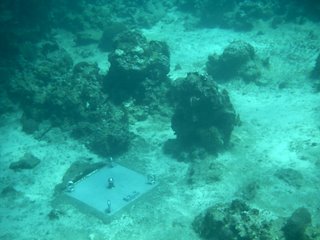 During the week of February 27, 2006, a supporting bottom plate was installed for a Coral Reef Early Warning System (CREWS) station near the Discovery Bay Marine Laboratory (DBML) on the north shore of Jamaica at 18o 28.367' N, 077 o 24.949' W by Jules Craynock, Hector Casanova (AOML), and John Halas (EMI), with supporting help from Jim Hendee (AOML) and Peter Gayle of DBML and his staff (Anthony Downes, Keeno Townes and Dalton).
During the week of February 27, 2006, a supporting bottom plate was installed for a Coral Reef Early Warning System (CREWS) station near the Discovery Bay Marine Laboratory (DBML) on the north shore of Jamaica at 18o 28.367' N, 077 o 24.949' W by Jules Craynock, Hector Casanova (AOML), and John Halas (EMI), with supporting help from Jim Hendee (AOML) and Peter Gayle of DBML and his staff (Anthony Downes, Keeno Townes and Dalton).The DBML CREWS station is being installed under a cooperative Caribbean program called Mainstreaming Adaptation to Climate Change (MACC) funded by World Bank and the Global Environmental Facility, with personnel support from NOAA and others. The main objective of the MACC project is to facilitate the creation of an environment for climate change adaptation in the Caribbean Community's small island and coastal developing states. Countries participating in the project are: Antigua & Barbuda; Bahamas; Barbados; Belize; Dominica; Grenada; Guyana; Jamaica; St. Kitts; St. Lucia; St. Vincent & the Grenadines; Trinidad & Tobago.
The CREWS station will measure wind speed and direction, precipitation, barometric pressure, air temperature, photosynthetically available radiation above and below the water, ultraviolet light above and below the water, sea temperature, salinity and partial pressure of carbon dioxide. The carbon dioxide studies are especially important in determining the influence of a changing global climate on coral reef growth patterns, while sea temperature and light studies help to determine the influence of a changing environment on the phenomenon of coral bleaching. The CREWS station will eventually provide data to establish long-term environmental trends. Such data and trends will support many ongoing and future research programs in coral reef ecosystem dynamics at DBML.